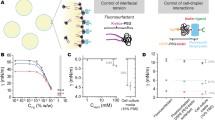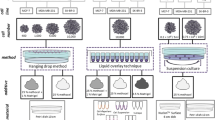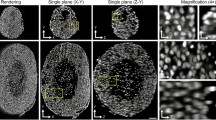Abstract
Multicellular aggregates (spheroids) represent an intermittent level between monolayer growing cells and tissue culture. Spheroids are rather objective model of the three-dimensional growth and organization, the cell-to-cell interactions and influence of microenvironmental conditions on tumour microaggre-gates. In our work formation and growth of spheroids depends on concentration of CMC and FCS. Conditions of microenvironment influence on intensiveness of proliferation as well as on cells adhesiveness and formation of microaggregates.
Similar content being viewed by others
References
Muller-Klieser, W., Three-Dimensional Cell Cultures: from Molecular Mechanisms to Clinical Application, Am. J. Physiol., 1997, vol. 273, pp. C1109–C1123.
Neman, T., Norling, B., Glimelius, D., Carlsson, J., and Brunk, B., Demonstration of Extracellular Matrix in Mul-ticellulur Tumor Spheroids, Cancer Res., 1984, vol. 44, p. 3090.
Brauner, T. and Hulser, D., Tumor Cell Invasion and Gap Junctional Formation, Invasion Metastasis, 1990, vol. 10, p. 31.
Sutherland, R.M., Cell and Environment Interactions in Tumor Microregions: the Multicellular Spheroids Model, Science, 1988, vol. 240, p. 177.
Bjerkvig, R., Spheroid Culture in Cancer Research, London: CRS press, 1992, p. 320.
Kelm, J.M., Timmins, N.E., Brown, C.J., Fussenegger, M., and Nielsen, L.K., Method for Generation of Homogeneous Multicellular Tumor Spheroids Applicable to a Wide Variety of Cell Types, Biotechnol. Bioeng., 2003, vol. 83, no. 2, pp. 173–180.
Yuhas, J., Tarleton, A.E., and Mon, K.B., Multicellular Tumor Spheroid Formation by Breast Cancer Cells Isolated from Different Sites, Cancer Res., 1978, vol. 38, p. 2486.
Perepelitsyna, O.M., Garmanchuk, L.V., and Sidorenko, M.V., Multicellular Spheroids of Brest Cancer Cells Generation Conditions and Effect of Serum Factors, Bukovin. med. visn., 2007, vol. 11, no. 3, pp. 128–133.
Gluzman, D.F., Sidorenko, S.P., and Nadgornaya, V.A., Tsitokhimiya i immunologya Zlokachestvennykh limfoproliferativnykh zabolevaniy (Cytochemistry and Immunology of Malignant Lymphoproliferative Diseases), Kiev, 1982 [in Russian].
Mosmann, T., Rapid Colorimetric Assay for Cellular Growth and Survival: Application to Proliferation and Cytotoxic Assayas, J. Immunol. Meth., 1983, vol. 65, pp. 55–63.
Author information
Authors and Affiliations
Corresponding author
Additional information
The article is published in the original.
About this article
Cite this article
Garmanchuk, L.V., Perepelitsyna, E.M., Sydorenko, M.V. et al. Formation of multicellular aggregates under different conditions of microenvironment. Cytol. Genet. 44, 19–22 (2010). https://doi.org/10.3103/S0095452710010044
Received:
Published:
Issue Date:
DOI: https://doi.org/10.3103/S0095452710010044




